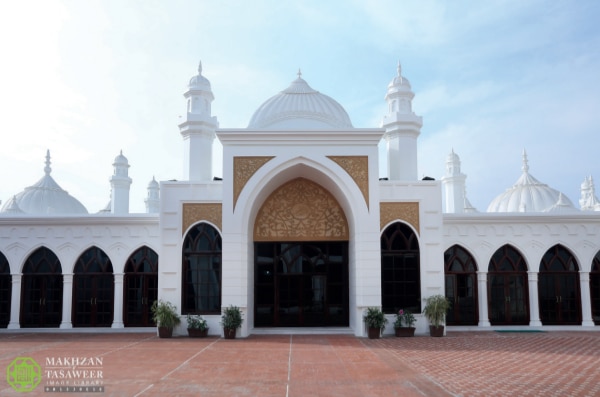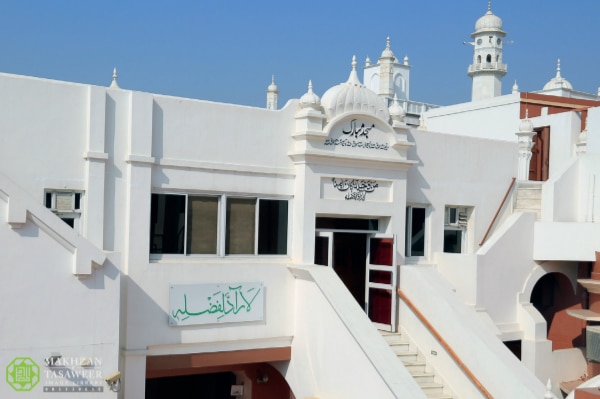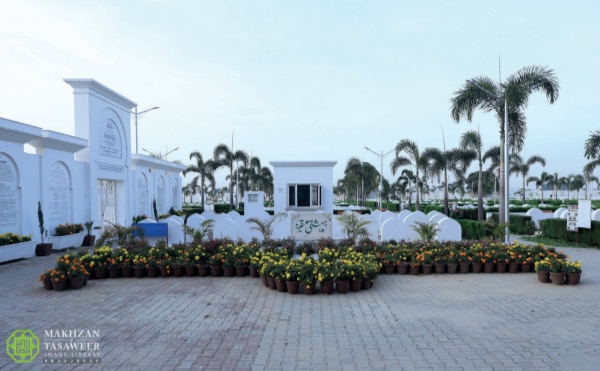A series looking at the high standard of morals of the Promised Messiahas and his Khulafa when receiving visitors in Qadian
Awwab Saad Hayat, Al Hakam

According to a revelation of God vouchsafed to the Promised Messiahas, people of various walks of life and from distant lands would travel to Qadian. As a result of this grand prophecy, Qadian continued to attract visitors even after the partition of India in 1947.
Below are words extracted from Prof Muhammad Aslam’s book, Safarnama-e-Hind, about two journeys that took place in Qadian during Hazrat Khalifatul Masih IV’srh Khilafat.
This is a narration of a non-Ahmadi guest who wrote about his visit and the Darweshan-e-Qadian (313 Ahmadis that chose to remain behind to protect Qadian after the partition of India) of the time and presented them in his writings in a negative manner.
While reading this book, it seems that this author, despite acquiring and attaining various degrees was content with mere hearsay and refrained from conducting his own research.
On page 406 of the book mentioned above, with regard to his journey to Kashmir, he wrote:
“There is a grave of a man named Yuz Asaf in the area of Khanyar, Srinagar. The Mirzais [Ahmadis] have made it famous as the tomb of Jesusas. Khawaja Kamaluddin (d. 1932) has even written a book on this subject in English. He says that Jesus did not die on the cross. When he was put on the cross on Friday afternoon, the day of Sabbath followed afterwards. When the guards left, the Christians took him off the cross and healed his wounds. When he recovered, he secretly reached Kashmir where he spent the rest of his life. His mother, Hazrat Maryam, also travelled to Kashmir from Jerusalem […] Mirza Ghulam Ahmad’s ‘prophethood’ is based on such misconceptions.” (Safarnama-e-Hind, pp. 406-407)
In this article, with regard to the way the author has described Qadian, the people of Qadian and Jamaat-e-Ahmadiyya, we shall simply cite his words, without answering and commenting on the satire he has adopted. The reason for this is that Hazrat Musleh-e-Maudra once explained:
جس كو تم كہتے ہو یارو یہ فنا ہوجائے گا
ایک دن سارے جہاں كا پىشوا ہوجائے گا
قوم كے بغض و عداوت كى نہیں پروا ہمیں
وقت یہ كٹ جائے گا، فضلِ خدا ہو جائے گا
That is, “Alluding to [Qadian] you say, ‘Friends! This place will perish.’ But it shall one day be the leader and guide for the whole world. We care not about the hatred and enmity of a nation, for this time shall pass, and God’s grace shall be manifest.”
One should remember that Prof Muhammad Aslam was a renowned Urdu writer, historian, educator, researcher and former president of the department of history at Punjab University. He was well-known as the founder of obituaries in Pakistan. His books, Khuftgan-e-Karachi, Khuftgan-e-Khak-e-Lahore and Wafiyat Mashahir Pakistan are well-known throughout Pakistan.
Prof Muhammad Aslam Sahib was born on 28 November 1932 in British India, Jalandhar District, Punjab Province. His father’s name was Tufail Muhammad. He was educated from first-class to MA (Master of Arts) in Lahore. After acquiring an MA, he moved to England in 1958 where he obtained a BA (Bachelor’s degree) from Durham University, following which he did an MA in Persian from Manchester University and attained MLitt (Master of Letters) degree from Cambridge University.
He returned home in 1967 and was appointed as a lecturer in the department of history at Punjab University. He reached his retirement as professor and president of the history department on 27 November 1992. He married the daughter of Saeed Ahmad Akbarabadi. Prof Muhammad Aslam also remained the secretary of West Pakistan Urdu Academy for some time.
Prof Muhammad Aslam has written several important works on history and obituaries: Din-e-Ilahi aur us ka pas manzar (1970), Tarikhi Maqalaat (1970), Surmaya Umar (1972), Wafiyat-e-Mashahir Pakistan (1990), Khuftgan-e-Karachi (1991), Slatin-e-Dehli aur Shahaan-e-Mughliya ka zoq-e-Mosiqi (1992), Wafiyat-e-A‘yan-e-Pakistan (1992), Khuftgan-e-Khaq-e-Lahore (1993), Safarnama Hind (1995), Muhammad bin Qasim aur us ke ja nashin (1996).
Many books of Prof Muhammad Aslam are included in the curriculum of schools, colleges and universities in Pakistan. He also wrote dozens of papers. He died on 6 October 1998 in Lahore.
Prof Muhammad Aslam’s book, Safarnama-e-Hind, was in fact a collection of historical and religious, scientific, literary commentaries of places in India. It was first printed in 1995.
On page 413 of this book, in the chapter entitled “Amritsar, Batala and Qadian”, the details of his journey are given. On page 427 with reference to his stay and engagements in Batala, it is written:
“Parveen Pal [a local guide] (of Batala) and I were standing near the crematorium when a bus appeared. Parveen said that the bus was going to Qadian. ‘Will you go there?’
“When I enquired [how far it was], Parveen said that Qadian was only 10 miles from here and bus staff charged only one rupee per passenger. When the bus came close and stopped, we got on it. Along the way came a village named Wadala Granthian and we reached Qadian in 20 minutes.
“When we got off the bus at the bus stop, I saw a minaret in the distance. A thought came to my mind that it may or may not be the Minarat-ul-Masih. When we asked for directions, some shopkeepers guided us.
“As soon as we reached the path leading towards Minarat-ul-Masih, from a distance, we saw a rather large looking Qadiani, dressed in a shirt, pyjamas and a cap and coming towards us. As I approached, I greeted him with salaam. He replied to my salaam and introduced himself in these words: ‘My name is Abdur Rahim Aajiz. I am a retired government officer. I have taken up residence here for the service of religion after retirement. And I am the secretary of Anjuman Ahmadiyya.’
“I expressed my desire of visiting Bahishti Maqbarah and Masjid Aqsa. He replied, ‘We shall surely take you to see [the places you want to see. But first] let me show you some places.’

“Abdur Rahim Aajiz took us to see the residence of Mirza Ghulam Ahmad Qadiani (d. 1908). He showed us a room. There were niches in all four walls [of the room]. In Arabic, such a shelf is called mishkaat. Abdur Rahim Aajiz told me that Mirza Sahib was accustomed to walking and writing. Mirza Sahib would have a pen and paper in his hands and would write by dipping his pen in these inkpots. I said, ‘That’s the way of the masha’een [a method adopted by Greek philosophers, like Aristotle, who would walk around whilst delivering lectures at the Athens stadium].’ He [Abdur Rahim Aajiz] smiled and said, ‘If you think so, then it must be so.’ There was another small room within this room and to enter it, one must climb up two or three stairsteps. This room is called Dar-ul-Huzn [Bait-ul-Dua]. We are told that Mirza Sahib used to sit in this room and weep over the plight of the ummah. There was another similar room called Dar-ul-Fikr. Sitting in this room, Mirza Sahib used to contemplate over the matters relating to the [Muslim] ummah and would enter Masjid Mubarak through this room. This mosque was adjacent to his house.

“Mirza Waseem Ahmad, the grandson of Mirza Ghulam Ahmad, lives in a house adjoining this house. He is the head [nazir-e-ala wa amir-e-muqami] of the Qadianis of India. In those days, he had gone to Hyderabad Deccan, which is why we could not meet with him.
“From here, Abdul Rahim Aajiz took us to Masjid Aqsa. Water was being sprinkled on the floor there. We were told that at the time of Maghrib, all the Qadiani men and women of Qadian gather in this mosque and a veil is put in the middle.
“From Maghrib to Isha, sermons and exhortations continued. The Minarat-ul-Masih was being repaired in those days and marble was being laid on its outer surface. Abdur Rahim Aajiz told me to go up [the staircase of] the minaret. I apologised, but he insisted. At his insistence, I climbed the staircase and began panting. (If I died, they would have buried me there in Bahishti Maqbarah.) As I caught my breath, I looked around and saw the view was clear and I could see miles ahead. On one side, I saw a clump of trees. I thought to myself, this could be the Bahishti Maqbarah.

“In the courtyard of Masjid Aqsa is the grave of Mirza Ghulam Murtaza (d. 1876), father of Mirza Ghulam Ahmad Qadiani. In Punjab, Sir Lepel Griffin and Colonel Massy testified that Ghulam Murtaza was always on military service during his visit to Nau Nihal Singh, Sher Singh and Darbar Lahore. In 1841, he was sent to Mandi and Kullu with General Vinchora. In 1843, he was sent to Peshawar as an infantry commander. He made a name for himself in the Hazara uprising and when the uprising of 1848 took place, he remained loyal to his government and fought on its behalf. His brother, Ghulam Mohi-ud-Din, also rendered good services on this occasion.
“Elsewhere, these two historians [Sir Lepel Griffin and Colonel Massy] write that this family rendered great services during the mutiny of 1857 [Indian Rebellion of 1857]. Ghulam Murtaza did not recruit many men; and his son, Ghulam Qadir, was in the army of General Nicholson, Sahib Bahadur [a title given to Indian Muslims and Parsis during the British rule], when the officer crushed the insurgents of 46th Infantry Division at Trimmu Head Chenab River. General Nicholson, Sahib Bahadur, gave a certificate to Ghulam Qadir in which it was written that in 1857, the Qadian family of Gurdaspur district was far more loyal than other families. This is what is known as ‘Jadu wo jo sar char kr bole’ [a trick or plan is good when it succeeds and is admired even by the rival].
“When I finished the visit of Masjid Aqsa, Abdur Rahim Aajiz asked his son, Abdul Hafeez, to take us to Bahishti Maqbarah and tell the doorkeeper there that we were given special permission to see Bahishti Maqbarah at this time […]”.

